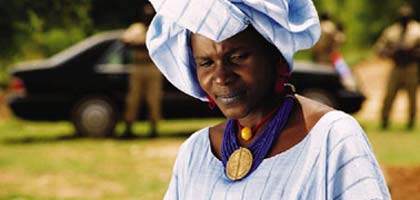Primary navigation


A powerful tale of the aftermath of a fictionalised civil war - inspired by the genocide in Rwanda - has Shakespearean resonances. By Philip Kemp
The tenth anniversary of the horrendous 100 days of genocide in Rwanda has already brought us one fine feature film in Terry George's Hotel Rwanda. Also in the pipeline is Michael Caton-Jones' Shooting Dogs. Both films are based on true stories. Fanta Régina Nacro's feature debut takes a less head-on approach, one aimed at universalising the tragedy. The Night of Truth is set in a fictitious west African country rent by 10 years of civil war; and though Nacro clearly has Rwanda in her sights, her film could equally draw on the experience of Sierra Leone, Sudan, Zaire, Uganda or, indeed, Yugoslavia. As she herself says, "Yugoslavia reminded people that African countries don't have a monopoly of horror".
Barring a brief coda, the action takes place over a period of a few hours on the day when two warring sides, having agreed a fragile truce, come together for what's planned as a feast of reconciliation. The conflict, as in Rwanda, is tribal: the Bonande, led by the charismatic Colonel Theo, have rebelled against the oppressive rule of the Nayak, represented by President Miossoune. Nacro emphasises the split between the tribes by having them speak different languages: Dioula and Mooré, the two main tongues of the director's native Burkina Faso. When they want to communicate with each other they have to use French, the language of the former colonial power.
Language isn't the only separating force. As in so many tribal conflicts, each side facilitates the killing by dehumanising its opponents. A Bonande refers to the Nayak as "cockroaches" (recalling the hate-filled ranting of the Hutu radio station that unleashed the slaughter of Rwanda's Tutsi minority with the cry, "kill the cockroaches!"); and Tomota, the shambling fool whose impetuosity triggers the film's catastrophe, tells stories about the Nayak being half-human, half-snake. These racist folk tales are reflected in a scene in which each of the two leaders gingerly nibbles at the choicest delicacies of the other's tribe - braised snake, a Nayak speciality, and roast caterpillars, much prized by the Bonande. (In an interview with a Swiss journalist, the director spoke of her reaction when offered, on a visit to Italy, "a cheese full of green bits. It was as repellent for me as eating caterpillars would be for you".) At this juncture the treatment of the people/food trope is humorous. But it's horrifyingly reprised when Edna, the president's wife crazed with grief over the death of her son, capers gleefully round the tortured body of Colonel Theo as he's roasted to death over a slow fire, basting him with his own blood and calling him "king of the marinade".
Given that The Night of Truth is the first ever sub-Saharan African feature to be directed by a woman, the film's female roles take on added significance. Generally in west African cinema women are seen as a force for moderation: the men tend to be headstrong, short-fused and reckless, while the women try to restrain them - or look on sardonically with that characteristic teeth-sucking sound that suggests a mix of contempt and incredulity. In Nacro's film it's Theo's wife, Soumari, who fills this traditional role. "Men make peace, men make war. It's nothing to do with me and the children," she tells her husband. But, despite her words, she's constantly at work trying to make the truce hold: banning a ritual drum that might awaken bloody memories; pouring out a libation on the ground to appease the dead of both sides; co-opting the president to support her in urging all the soldiers to set down their arms and mingle as brothers. She resignedly accepts the fact that the man who tortured her father to death won't face execution, acknowledging that, at some point, the vengeful cycle of blood-letting must cease.
Over against her stands the figure of Edna, unable to forget how her only child, Michel, was obscenely mutilated and killed during a massacre of Nayaks by Bonandes in the town of Govinda. Begging her husband to let her stay away from the feast, Edna says: "I'm scared of fear... of hate." But as it turns out it's her own emotions, rather than those of the former enemy, that she's scared of. Her counterpart is Colonel Theo, haunted by his involvement in the same massacre. With fatal inevitability, these two are drawn together; and when he kneels and asks her forgiveness, she chillingly responds "forgiveness is God's business, not mine", and then sets her terrible scheme of vengeance in motion. (The film, incidentally, is dedicated to the memory of the director's uncle, who was tortured to death in the same atrocious fashion.
Nacro has said that in setting her film in a fictitious country she was aiming at the universality of a parable with Shakespearean overtones; and in the character of Colonel Theo, a leader who commands the love as well as the loyalty of his men, there's certainly a strong element of Shakespeare' 'flawed heroes' - commanding figures destroyed by one besetting fault. The Antony of Antony and Cleopatra comes particularly to mind; and maybe also, given the people/food nexus, Titus Andronicus. We're perhaps meant to view as his 'flaw' his lapse into blood-crazed cruelty during the Govinda massacre. ("I felt strong as a god - I felt powerful," he says.) But this is one example of the director's decision to cast non-professional actors, members of the Burkina Faso armed forces, in most of her male roles letting her down. As Theo, Moussa Cissé can't quite carry off this speech with conviction; and it's equally hard to credit that the leader of a ten-year uprising would be amazed and shocked at encountering "men who liked to kill". It's more credible, perhaps, to see Theo's fatal flaw as over-confidence: he brushes aside the warnings of his wife and brother with a complacent "I know what I'm doing".
The strength of Nacro's film lies not so much in its plot, which occasionally errs on the side of predictability, as in the all-too-convincing texture of its portrayal of a country traumatised by a decade of hatred and slaughter. Throughout the movie we can glimpse, almost casually in the background of the action, walls on which women are painting vigorous, graphic pictures - all of them depicting mutilation and killing. Even more chilling is a gathering of children aged ten or younger who casually tease each other about the various injuries and amputations they've suffered.
These details, as much as the nightmarish flashbacks of landscapes strewn with severed body parts, reinforce the sense of a country where the cruellest, most extreme violence has become a commonplace, part of the very fabric of life. Small wonder if the banal tree-planting ceremony intended to mark the moment of reconciliation proves hopelessly inadequate. A blood sacrifice is needed to seal the pact, an act of horror commensurate with the horrors that have preceded it.
The film ends on a note of optimism, with Tomota reporting to his dead commander on a nation at peace, and schoolchildren learning a text that speaks of unity. But so powerful is the preceding portrayal of a poisoned legacy of hate and fear, that you can't help wondering how long this peace will hold.